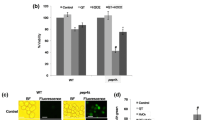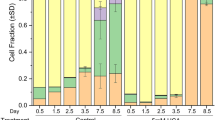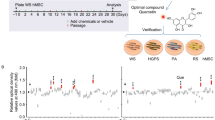Abstract
The Saccharomyces cerevisiae TEL1 gene is an ortholog of the human ATM (Ataxia telangiectasia mutated) gene. S. cerevisiae tel1 mutant (tel1∆) lacking Tel1p, share some of the cellular defects with ATM mutation that includes prevention of oxidative damage repair, premature aging and apoptosis. In the present study, we investigated the protective effects of quercetin on the sensitivity of yeast S. cerevisiae tel1∆ cells exposed to oxidative, apoptotic and DNA damaging stress and viability of tel1∆ cells during chronological aging. Quercetin improved the stress resistance of tel1∆ cells when challenged with oxidants such as hydrogen peroxide (H2O2), menadine bisulphite (MBS) and tertiary butyl hydroperoxide (t-BHP) by scavenging reactive oxygen species (ROS). Quercetin protected the tel1∆ cells from acetic acid-induced apoptotic cell death and sensitivity against hydroxyurea. We found that quercetin attenuated ROS accumulation and apoptotic markers in tel1∆ cells and therefore an increase in cell viability during chronological aging. Our results from the S. cerevisiae model, suggest that use of quercetin as a food supplement might alleviate oxidative stress mediated DNA damage, apoptosis and age related damaging effects in AT patients and also improve health beneficial effects in humans.







Similar content being viewed by others
References
Baldo V, Testoni V, Lucchini G, Longhese MP (2008) Dominant TEL1-hy mutations compensate for Mec1 lack of functions in the DNA damage response. Mol Cell Biol 28:358–375
Boots AW, Haenen GR, Bast A (2008) Health effects of quercetin: from antioxidant to nutraceutical. Eur J Pharmacol 585:325–337
Chabes A, Georgieva B, Domkin V, Zhao X, Rothstein R, Thelander L (2003) Survival of DNA damage in yeast directly depends on increased dNTP levels allowed by relaxed feedback inhibition of ribonucleotide reductase. Cell 112(3):391–401
Doudican NA, Song B, Shadel GS, Doetsch PW (2005) Oxidative DNA damage causes mitochondrial genomic instability in Saccharomyces cerevisiae. Mol Cell Biol 25(12):5196–5204
Edwin Shackelford R, Manuszak RP, Heard SC, Link CJ, Wang S (2005) Pharmacological manipulation of ataxia-telangiectasia kinase activity as a treatment for Parkinson’s disease. Med Hypotheses 64:736–741
Fabrizio P, Longo VD (2007) The chronological life span of Saccharomyces cerevisiae. Methods Mol Biol 371:89–95
Ferreira TC, de Moraes LM, Campos EG (2011) Cell density-dependent linoleic acid toxicity to Saccharomyces cerevisiae. FEMS Yeast Res 11(5):408–417
Guo Z, Kozlov S, Lavin MF, Person MD, Paull TT (2010) ATM activation by oxidative stress. Science 330:517–521
Harwood M, Danielewska-Nikiel B, Borzelleca JF, Flamm GW, Williams GM, Lines TC (2007) A critical review of the data related to the safety of quercetin and lack of evidence of in vivo toxicity, including lack of genotoxic/carcinogenic properties. Food Chem Toxicol 45(11):2179–2205
Heijnen CG, Haenen GR, Vekemans JA, Bast A (2001) Peroxynitrite scavenging of flavonoids: structure activity relationship. Environ Toxicol Pharmacol 10(4):199–206
JECFA (1977) Evaluation of certain food additives. In: Proceedings of 21st JECFA session, April, 18–27, 1977, Geneva, Switzerland. WHO technical report series, no. 617. World Health Organization (WHO), Joint FAO/WHO Expert Committee on Food Additives (JECFA) & Food and Agriculture Organization of the United Nations, Geneva, Switzerland
Kamsler A, Daily D, Hochman A, Stern N, Shiloh Y, Rotman G, Barzilai A (2001) Increased oxidative stress in ataxia telangiectasia evidenced by alterations in redox state of brains from Atm-deficient mice. Cancer Res 61:1849–1854
Kwolek-Mirek M, Zadrag-Tecza R (2014) Comparison of methods used for assessing the viability and vitality of yeast cells. FEMS Yeast Res 14:1068–1079
Li Y, Yao J, Han C, Yang J, Chaudhry MT, Wang S, Liu H, Yin Y (2016) Quercetin, inflammation and immunity. Nutrients 8:167
Ludovico P, Sousa MJ, Silva MT, Leao C, Corte-Real M (2001) Saccharomyces cerevisiae commits to a programmed cell death process in response to acetic acid. Microbiology 147:2409–2415
Madeo F, Frohlich E, Frohlich KU (1997) A yeast mutant showing diagnostic markers of early and late apoptosis. JCell Biol 139:729–734
Malakar D, Dey A, Basu A, Ghosh AK (2008) Antiapoptotic role of S-adenosyl-l-methionine against hydrochloric acid induced cell death in Saccharomyces cerevisiae. Biochem Biophys Acta 1780(7–8):937–947
Marchetti MA, Weinberger M, Murakami Y, Burhans WC, Huberman JA (2006) Production of reactive oxygen species in response to replication stress and inappropriate mitosis in fission yeast. J Cell Sci 119(Pt 1):124–131
Menotta M, Biagiotti S, Bianchi M, Chessa L, Magnani M (2012) Dexamethasone partially rescues ataxia telangiectasia-mutated (ATM) deficiency in ataxia telangiectasia by promoting a shortened protein variant retaining kinase activity. J Biol Chem 287(49):41352–41363
Naidu PS, Singh A, Kulkarni SK (2003) Quercetin, a bioflavonoid, attenuates haloperidol-induced orofacial dyskinesia. Neuropharmacology 44:1100–1106
Nakayashiki T, Mori H (2013) Genome-wide screening with hydroxyurea reveals a link between nonessential ribosomal proteins and reactive oxygen species production. J Bacteriol 195(6):1226–1235
Ocampo A, Liu J, Barrientos A (2003) NAD+ salvage pathway proteins suppress proteotoxicity in yeast models of neurodegeneration by promoting the clearance of misfolded/oligomerized proteins. Hum Mol Genet 22(9):1699–1708
Outeiro TF, Lindquist S (2003) Yeast cells provide insight into alpha-synuclein biology and pathobiology. Science 302:1772–1775
Poletto M, Yang D, Fletcher SC, Vendrell I, Fischer R, Legrand AJ, Dianov GL (2017) Modulation of proteostasis counteracts oxidative stress and affects DNA base excision repair capacity in ATM-deficient cells. Nucleic Acids Res 45(17):10042–10055
Reichenbach J, Schubert R, Schindler D, Muller K, Bohles H, Zielen S (2002) Elevated oxidative stress in patients with ataxia telangiectasia. Antioxid Redox Signal 4:465–469
Reliene R, Schiestl RH (2008) Experimental antioxidant therapy in ataxia telangiectasia. Clin Med Oncol 2:431–436
Shackelford RE, Innes CL, Sieber SO, Heinloth AN, Leadon SA, Paules RS (2001) The Ataxia telangiectasia gene product is required for oxidative stress-induced G1 and G2 checkpoint function in human fibroblasts. J Biol Chem 276:21951–21959
Shackelford RE, Manuszak RP, Johnson CD, Hellrung DJ, Link CJ, Wang S (2004) Iron chelators increase the resistance of Ataxia telangiectasia cells to oxidative stress. DNA Repair 3:1263–1272
Singh A, Xu YJ (2016) The cell killing mechanisms of hydroxyurea. Genes (Basel) 7(11):99
Sousa M, Duarte AM, Fernandes TR, Chaves SR, Pacheco A, Leao C, Corte-Real M, Sousa MJ (2013) Genome-wide identification of genes involved in the positive and negative regulation of acetic acid-induced programmed cell death in Saccharomyces cerevisiae. BMC Genom 14:838
Ting Y, Chang WT, Shiau DK, Chou PH, Wu MF, Hsu CL (2018) Antiobesity efficacy of quercetin-rich supplement on diet-induced obese rats: effects on body composition, serum lipid profile, and gene expression. J Agric Food Chem 66(1):70–80
Vilaca R, Mendes V, Mendes MV, Carreto L, Amorim MA, de Freitas V, Moradas-Ferreira P, Mateus N, Costa V (2012) Quercetin protects Saccharomyces cerevisiae against oxidative stress by inducing trehalose biosynthesis and the cell wall integrity pathway. PLoS ONE 7:e45494
Yi M, Rosin MP, Anderson CK (1990) Response of fibroblast cultures from ataxia-telangiectasia patients to oxidative stress. Cancer Lett 54:43–50
Zannolli R, Buoni S, Betti G, Salvucci S, Plebani A, Soresina A, Pietrogrande MC, Martino S, Leuzzi V, Finocchi A, Micheli R, Rossi LN, Brusco A, Misiani F, Fois A, Hayek J, Kelly C, Chessa L (2012) A randomized trial of oral betamethasone to reduce ataxia symptoms in ataxia telangiectasia. Mov Disord 27(10):1312–1316
Zhang Y, Ma WY, Kaji A, Bode AM, Dong Z (2002) Requirement of ATM in UVA-induced signaling and apoptosis. J Biol Chem 277:3124–3131
Acknowledgements
The authors thankful to UGC-BSR (F NO 42-665/2013 (SR dated 25-03-2013)) for supporting this work and DBT-IPLS, DST-FIST for providing infrastructure. Phaniendra Alugoju thank to Pondicherry University and UGC-BSR Research fellowship F-7-370/2012 (BSR) for providing fellowship for the financial assistance.
Author information
Authors and Affiliations
Corresponding author
Ethics declarations
Conflict of interest
Authors declare that there is no conflict of interest.
Rights and permissions
About this article
Cite this article
Alugoju, P., Periyasamy, L. & Dyavaiah, M. Quercetin enhances stress resistance in Saccharomyces cerevisiae tel1 mutant cells to different stressors. J Food Sci Technol 55, 1455–1466 (2018). https://doi.org/10.1007/s13197-018-3062-9
Revised:
Accepted:
Published:
Issue Date:
DOI: https://doi.org/10.1007/s13197-018-3062-9




